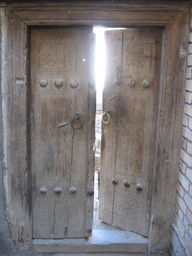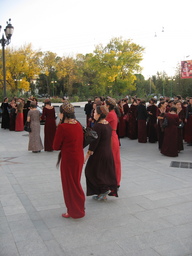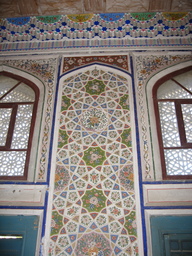
Door to Mubinjon's
 Door to Mubinjon's |
I have so liked the people I've met over my first couple days in Turkmenistan. I had a great time viewing architecture around Uzbekistan, but the people I've met so far in Turkmenistan have been friendlier, more open, and curious to chat with me. More smiles all around.
Perhaps there is more interaction because I stand out more here. It's not my features: they still blend in well. One employee at the Mary Museum actually mistook me for a local Turkmen guide leading a group of foreign visitors. I think what makes me stand out here is language. The Turkmen and Uighur languages are similar enough that I have no problem being understood, yet they are far enough apart that I understand less of what people say to me. Uighur and Uzbek share more similarities than Uighur and Turkmen.
Turkmen, Uzbek, Kazakh, Kyrgyz, Uighur--these all belong to the same language family. I've come up with an analogy to explain the similarities I've found across Turkic languages:
If the first language of everybody across Europe were English, but elements of the vocabulary and pronunciation varied from country to country, that would be similar to what I'm encountering across Central Asia.
In this hypothetical native-English speaking Europe, a sentence might sound something like, "I am voyaging to the market to purchase fresh lait and queso." The accent and choice of words would vary from country to country.
 Turkmen Women |
Everybody here seems to be relaxed and interested in chatting, asking where I'm from, inviting me to tea. It is a lot harder to get a visa to visit Turkmenistan than to visit Uzbekistan, so there is probably something of a novelty factor behind the increased attention. That said, even places I wouldn't expect--such as crossing the border--the guards were friendly and joking around. The woman on duty at the Internet cafe I visited in Mary encouraged me to find a Turkmen friend, then bring him along with me so I could pay the local rate. (Internet access is strictly regulated across Turkmenistan. Access points are scarce, what few Internet cafes exist log names and passport numbers, even of local users.)
Aside from the mannerisms, the fashion in Turkmenistan is different from what people wear in Uzbekistan. Most women wear ankle-length dresses cinched at the waist. Embroidery runs around the collar, then down a line along the chest. People--especially younger boys and girls--wear traditional skullcaps woven into beautiful, colorful patterns.
 Wall and Ceiling of my Room at Mubinjon's |
This trip to Samarkand I visited several places I didn't make it to over my first visit. I wandered around the archaeological site of Afrosiab, a civilization which had its heyday a couple thousand years ago. There weren't many structural remains at the site of Afrosiab, but, as with some of the other archaeological sites I have visited, (e.g. Harappa) there were pottery shards lying about everywhere. I would presume that a century or two would be enough to return those objects to the earth.
Another place I visited in Samarkand was the Shah-i-Zindah, a row of mausoleums decorated in ornate tilework and calligraphy. I also did make a return to that Armenian restaurant I was so fond of, but they didn't have the stuffed tomato dish I liked so well the last time.
In Bukhara, I largely took it easy: the place I stayed in was amazing in and of itself. I spent a few days at a homestay in an old house in Bukhara's old city. The house was built in 1776, the owner a friendly--if nutty--Tajik man named Mubinjon. The house was huge and beautiful, obviously from another era. It had its own interior courtyard; solid, wooden doors closed with latches, chains, and rings; and several alcoves decorated with ornate trim. Mubinjon was going through the process of restoration room by room, re-painting floral designs and Persian calligraphy in the interior of each.
 Cobbler |
I couldn't really follow all that he was saying, from what I gathered he worked in the neighborhood as a streetsweeper. For some reason he had access to kegs of beer imported from Bavaria and was being hospitable, offering a guest some of what he had. He told me to wait, which I really had no choice but to do--my shoes were being mended. He came back a minute later with a huge plastic bottle with a Coca-Cola label on it, sealed with a blue Fanta cap. Inside was some amber-colored liquid.
"It's beer. Good beer. Bavarian beer. Not that crummy Uzbek stuff," he insisted. "Try some." I took a sip, partly out of politeness, partly to determine that it really was beer. I tried to refuse, but he insisted that I take the whole bottle home. The contents were easily enough for two or three people to share over an evening of drinking.
It was good beer.